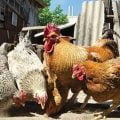Protecting Nests and Eggs Boosts Turtle Populations
Turtle nests are very prone to being dug up by animals such as raccoons, which use the eggs as food. Unfortunately, as a result, very few eggs survive long enough to hatch. Although the eggs are a normal food source for many different animals, turtle populations need all the help they can get right now, with all eight of Ontario’s native species considered “at risk” federally. If the nest is protected, the eggs have a chance to hatch.

Don’t give in to the temptation to “take a peek” at the eggs. Some hatchlings will overwinter in the nest, so leave nests alone, even if the hatchlings have not yet emerged when you expected them to.
Turtles Choose Their Nest Sites Carefully
Turtles are very picky as to where they lay their eggs, so they will take a long time to decide on the location of their nest. As a result, property owners will often see the female “hanging out” for some time, even before digging the nest. Actually digging the nest and laying the eggs is a time-consuming activity. Turtles, after all, do everything slowly!
June is the most common month to see turtles laying eggs in Ontario. So, please do not disturb them during this time.

Nest Protectors
Nest protectors can be purchased at the Ontario Turtle Conservation Centre in Selwyn, Ontario, or at ontarioturtle.ca; all proceeds go toward the care of Ontario’s turtles. There are also plans available on the OTCC website to build your own nest protector. It is very important that a nest protector be made from the correct materials and be installed correctly. It is also vital that the nest protector allows for natural elements like the rain and sun to pass through and that the temperature of the nest is not affected in any way.
The OTCC nest protector is a very easy one to install and will allow for safe protection of turtle nests. The cage is basically a frame that measures 2 feet by 2 feet; it can be built with two-by-fours and narrow-gauge mesh (carpenter’s cloth). The cage is held in place with long spikes nailed into the ground, which deters raccoons from pushing the cage aside. It’s critical that notches are cut into two sides of the frame, so the hatchlings can leave the nest when they emerge.
Place the nest protector over the top of the nest, with the nest centred in the middle; be careful not to disturb the nest itself. Into each corner of the wooden frame, hammer a stake all the way down into the dirt to prevent movement or disturbance. Ensure the notches are free from vegetation.

Donations are critical to the Ontario Turtle Conservation Centre’s ability to continue helping Ontario’s turtles. Donations are always welcome and all go toward turtle conservation. Visit ontarioturtle.ca to find out how to financially support the OTCC, a registered charity.













